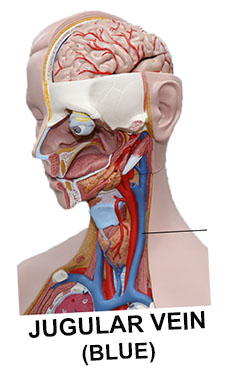
Migraine
This article advances the hypothesis that in many cases, migraine is a foodborne illness. The common causative microorganisms are a range of bacteria, including Lactobacillus strains used in the fermentation of milk and vegetables and affecting the decay of many foods. These bacteria convert amino acids into biogenic amines. All mammalian organisms use some amines as neurotransmitters and in the immune system, and can synthesize them themselves in necessary quantities. Excess amines, whether produced by an organism itself or entering the body as food, are broken down by amine oxidase enzymes present throughout any mammalian organism. The particularities of these enzymes are genetically encoded, and thus vary from person to person. Some people handle amines entering the body with food better than others. This is in line with migraine running in families. If excess biogenic amines are not broken down in a timely manner, they cause, in extreme cases, food poisoning, even fatal. On a lesser scale, so the hypothesis of this article, poorly managed excess biogenic amines cause migraine.
The US FDA, on its consumer pages, classifies 16 conditions as foodborne diseases. [What You Need to Know about Foodborne Illnesses]. Of those, 14 are caused by bacteria and 2 by viruses. Salmonella infection is the most well-known bacterial, and Hepatitis A the best-known viral foodborne disease.
The traditional view of migraine explained it as a vascular condition. During the aura phase, blood vessels around the skull were thought to be contracted (or cramped). This would reduce blood flow to the eyes, causing typical visual effects like flickering or blind spots, or other sensual deficiencies. Then the blood vessels would expand disproportionately and exert pressure on nerves around the skull, thus causing pain.
Turned out old science was wrong. When blood vessels were measured during the aura and headache phases, they weren't constricted or expanded in line with the theory. In 2009, Brain (one of the world's foremost journals of neurology, published by Oxford University Press since 1878) summarized the change of winds in the headline: "The vascular theory of migraine - a great story wrecked by the facts" [Brain, Volume 132, Issue 1, January 2009]
So, what is the link between migraine and cortical spreading depression. No interference with cortical spreading depression ever stopped a migraine, and it was never possible to induce a migraine by setting off a cortical spreading depression. All research on cortical spreading depressions was done in rabbits and cats. It wasn't even possible to prove the existence of cortical spreading depression in humans, unless a person had suffered extensive brain injury. Reason: cortical spreading depression propagates on the surface of brains. It does not jump easily over sulci (the furrows in brain folds) from brain gyri (bulged folds) to gyri; but heavily damaged brains do not have divided folds like healthy brains, thus cortical depressions spread more easily. During migraine attacks in humans, cortical spreading depression has never been measured (a fact for which neurologists came up with many excuses). [Persistent questions]
Wow! Just that?
Yeap.
As a scientific explanation for migraine, cortical spreading depression has probably undergone brain death.
Cortical spreading depression, however, is still very much alive in the marketing efforts of neurologists. YouTube is full of clips that have been uploaded by headache web sites. Neurologists want you to hire their services... elaborate diagnostics, expensive consultations which they bill to your insurance company. Roughly 20 percent of Americans suffer from migraine [Source: The Prevalence and Impact of Migraine and Severe Headache in the United States: Figures and Trends From Government Health Studies]. 65 million potential patients. If only half shows up for consultations with neurologists, that's going to be a bonanza.
Neurologists will prescribe neurological medications, typically expensive. Thus, big pharma is on the bandwagon of the neurologists.
The vascular, neurological, and inflammatory theories of migraine focus on what happens during migraine episodes. An entirely different perspective concentrates on what causes migraine episodes. Patients who are cured because they can avoid the causes of migraine attacks won't care much about what happens during them. Anyway, they no longer are afflicted.
Biogenic amines, mostly tyramine and histamine, have long been considered migraine triggers. In high enough dosages, tyramine and histamine in food make not just migraine sufferers sick, but any human.
Lists of prohibited and allowed foods for migraineurs are plentiful on non-academic websites. Many of these lists are dubious. It's not the specific foods that impact migraine sufferers, but the tyramine and histamine contents. And for any food, these vary from batch to batch, depending on several parameters.
As a drastic example, the histamine content of a tuna sandwich can vary by a factor of 1000 when the same tuna sandwich is bought at the same shop, but a week apart. Maybe their refrigerator broke down, you never know.
For one and the same kind of fruit, the tyramine load can vary by a factor of 100, depending on the condition under which if was harvested and how it was processed. Once the tyramine is in, you can't get it out, unless the whole lot is injected with amine oxidase enzymes that convert an amine group into ammonia, (NH3). Boiling, waving, or even deep-frying won't remove the tyramine or histamine, but can easily mask a taste that would otherwise betray spoilage.
To be meaningful at all, histamine and tyramine must be quantified. It's NOT that cheese is "prohibited" because it contains tyramine, and fruit and vegetables are "allowed".
The human body uses 20 amino acids to synthesize proteins. 9 are essential, they must come from nutrition. They are: histidine, isoleucine, leucine, lysine, methionine, phenylalanine, threonine, tryptophan, valine. Another 11 may come from food, or are derived by the human organism from essential amino acids. They are: alanine, arginine, asparagine, aspartic acid, cysteine, glutamic acid, glutamine, glycine, proline, serine, tyrosine
Human enzymes or enzymes of bacteria either within the human body or present in food we consume turn amino acids into amines by decarboxylation (the removal of carbondioxide, CO2, molecules).
The enzymatic derivates of amino acids include:
Histamine (a crucial amine in the immune system) from histidine
Most of these amines have important functions in the human body. Cadaverine, putrescine, spermidine, and spermine, and are needed in cells for protein synthesis and membranes. In human pathology, however, histamine and tyramine are the most relevant. And this article is focused on tyramine.
The following bacteria have been identified as generating tyramine:
Gram-positive: Bacillus thuringiensis. Carnobacterium divergens1, Enterococcus durans, Enterococcus hirae, Enterococcus faecalis, Enterococcus faecium, Lactobacillus brevis, Lactobacillus curvatus, Tetragenococcus halophilus
The most comprehensive list of tyramine measurements was compiled by Gaby Andersen, Patrick Marcinek, Nicole Sulzinger, Peter Schieberle, Dietmar Krautwurst and published in February 2019 in the journal Nutrition Reviews [Food sources and biomolecular targets of tyramine ]. Be prepared for some surprises.
Dairy (except cheese)
Buttermilk, 2.2 mg/kg, Souci et al (2016)
Cow’s milk, none detected, Novella-Rodriguez et al (2000)
Cream, 1.7 mg/kg, Souci et al (2016)
Sour cream, 1.4 mg/kg, Souci et al (2016)
Quark, 2.4 mg/kg, Souci et al (2016)
Yogurt, 1.3 mg/kg, Souci et al (2016)
Out of three tests, two were negative, and the one test that detected tyramine at all only found a very small amount. But mind you: spoiled yogurt can be loaded with tyramine up to dangerous levels. Lactobacillus varieties, responsible for yogurt fermentation, are the champions when it comes to the conversion of tyrosine to tyramine.
Cheese
A wide spectrum of measurements was reported for cheeses. For brie, it ranged from none detected to 260.0 mg/kg in tests conducted by one team, for parmesan 4.0 mg/kg to 290.0 mg/kg, for gauda 20.0 mg/kg to 670.0 mg/kg, for roquefort 27.0 mg/kg to 1100.0 mg/kg. For edam, it was 13.5 mg/kg to 310.0 mg/kg by three teams. For no food item are the measurements as confusing, and unequal, as they are for cheese. Different brands or batches of the same kind of cheese can have more than 50 times as much tyramine as other brands or batches, and you can't know why. It could be a flaw in the culture, or the aging process, or an event during transportation.
Appenzeller, 55.0 mg/kg, Souci et al (2016)
Brie, none detected to 260.0 mg/kg, Souci et al (2016)
Camembert, 37.0 mg/kg, Souci et al (2016)
Cheddar, 350.0 mg/kg, Souci et al (2016)
Edam, 310.0 mg/kg, Souci et al (2016)
Emmental, 42.0 mg/kg, Souci et al (2016)
Feta, 152.0 mg/kg to 246.0 mg/kg, Valsamaki et al (2000)
Gorgonzola, 8.0 mg/kg, Lange et al (2002)
Gouda, 20.0 mg/kg to 670.0 mg/kg, Souci et al (2016)
Gruyère, 37.0 mg/kg, Souci et al (2016)
Leerdammer, none detected, Mayr & Schieberle (2012)
Parmesan, 4.0 mg/kg to 290.0 mg/kg, Souci et al (2016)
Roquefort, 27.0 mg/kg to 1100.0 mg/kg, Souci et al (2016)
Tilsit, 32.0 mg/kg, Souci et al (2016)
Meat
Chicken liver, 100.0 mg/kg, Souci et al (2016)
Ham, cooked, 6.0 mg/kg to 108.0 mg/kg, Saccani et al (2005)
Ham, dry cured, 7.5 mg/kg, Lange et al (2002)
Onion sausage, 32.0 mg/kg, Lange et al (2002)
Ox liver, 270.0 mg/kg, Souci et al (2016)
Pork, fresh meat, none detected to 56.0 mg/kg, Saccani et al (2005)
Salami, 77.1 mg/kg, Mayr & Schieberle (2012)
Fish
Cod, 2.0 mg/kg, Lange et al (2002)
Fermented fish sauce, 276.0 mg/L to 357.0 mg/L, Kirschbaum et al (2000)
Herring, none detected, Lange et al (2002)
Herring, cured, none detected to 3000.0 mg/kg, Souci et al (2016)
Mackerel, 25.8 mg/kg to 27.4 mg/kg, Shakila et al (2001)
Mackerel in brine, none detected, Shakila et al (2001)
Mackerel salt-dried, 398.4 mg/kg to 413.8 mg/kg, Shakila et al (2001)
Salmon, none detected, Lange et al (2002)
Sardines, 16.2 mg/kg to 11.8 mg/kg, Shakila et al (2001)
Sardines in oil, none detected, Shakila et al (2001)
Sardine, salt-dried, 169.5 mg/kg to 178.1 mg/kg, Shakila et al (2001)
Seer fish, 9.4 mg/kg to 10.7 mg/kg, Shakila et al (2001)
Seer fish, salt dried, 154.2 mg/kg to 154.1 mg/kg, Shakila et al (2001)
Shrimp, 8.8 mg/kg to 12.6 mg/kg, Shakila et al (2001)
Shrimp, salt dried, 693.2 mg/kg to 704.7 mg/kg, Shakila et al (2001)
Tuna, 0.06 mg/kg, Mayr & Schieberle (2012)
Tuna in oil, 0.72 mg/kg, Souci et al (2016)
Alcoholic beverages
Beer, German Vollbier, 1.8 mg/L to 12.0 mg/L, Souci et al (2016)
Beer, alcohol-free, 1.2 mg/L, Souci et al (2016)
Wine, port, 0.51 mg/L, Cunha et al (2011)
Wine, red, none detected to 20.0 mg/L, Souci et al (2016)
Wine, white, none detected to 3.0, Souci et al (2016)
Apple, none detected, Tarjan & Janossy (1978)
Apple juice, 0.1 mg/L, Maxa & Brandes (1993)
Avocado, 23.0 mg/kg, Souci et al (2016)
Banana, 7.0 mg/kg, Souci et al (2016)
Currants, none detected, Tarjan & Janossy (1978)
Currant juice, freshly squeezed, 3.26 mg/L, Maxa & Brandes (1993)
Grape, 691.0 mg/kg, Tarjan & Janossy (1978)
Grape juice, 0.04 mg/L, Cunha et al (2011)
Grapefruit juice, freshly squeezed, 0.1 mg/L, Maxa & Brandes (1993)
Hazelnut, 1.8 mg/kg, Lavizzari et al (2006)
Orange, 10.0 mg/kg, Souci et al (2016)
Orange juice, 0.21 mg/L, Maxa & Brandes (1993)
Orange juice, freshly squeezed, 0.1 mg/L to 0.49 mg/L, Maxa & Brandes (1993)
Peach, none detected, Tarjan & Janossy (1978)
Pear, none detected, Tarjan & Janossy (1978)
Plum, none detected to 6.0 mg/kg, Souci et al (2016)
Raspberry, 10.0 mg/kg to 90.0 mg/kg, Souci et al (2016)
Raspberry juice, freshly squeezed, 66.66 mg/L, Maxa & Brandes (1993)
Watermelon, 460.0 mg/kg, Tarjan & Janossy (1978)
Vegetables
Beetroot, 160.0 mg/kg, Tarjan & Janossy (1978)
Cabbage, 670.0 mg/kg, Tarjan & Janossy (1978)
Chinese cabbage, 1.26 mg/kg, Simon-Sarkadi & Holzapfel (1994)
Cabbage, sauerkraut, 20.0 mg/kg, Souci et al (2016)
Cabbage, fermented juice, 37.1 mg/L to 73.0 mg/L, Kirschbaum et al (2000)
Kohlrabi, 930.0 mg/kg, Tarjan & Janossy (1978)
Carrot, 0.001 mg/kg, Sulzinger et al (2016)
Carrot juice, 0.002 mg/L, Sulzinger et al. (2016)
Cauliflower, 400.0 mg/kg, Tarjan & Janossy (1978)
Cucumber, 250.0 mg/kg, Tarjan & Janossy (1978)
Endive, 1.60 mg/kg, Simon-Sarkadi & Holzapfel (1994)
Green pea, frozen, 8.7 mg/kg, Kalac et al (2002)
Haricot bean, 160.0 mg/kg, Tarjan & Janossy (1978)
Iceberg lettuce, 0.94 mg/kg, Simon-Sarkadi & Holzapfel (1994)
Miso, 24.6 mg/kg to 349.0 mg/kg, Kirschbaum et al (2000)
Olives, none detected, Lange et al (2002)
Paprika, 266.0 mg/kg, Tarjan & Janossy (1978)
Potato, 1.14 mg/kg, Sulzinger et al. (2016)
French fried potatoes, raw, 0.77 mg/kg, Sulzinger et al. (2016)
Radicchio, 2.73 mg/kg, Simon-Sarkadi & Holzapfel (1994)
Radish, 200.0 mg/kg, Tarjan & Janossy (1978)
Soy sauce, 17.7 mg/L to 172.0 mg/L, Kirschbaum et al (2000)
Soybeans, 9.05 mg/kg, Bartkiene et al (2015)
Soybean, fermented, 27.8 mg/kg to 416.1 mg/kg, Bartkiene et al (2015)
Sufu, fermented tofu, none detected to 1125.4 mg/kg, Yen (1986)
Spinach, 3.78 mg/kg, Sulzinger et al. (2016)
Spinach purée, frozen, 10.2 mg/kg, Kalac et al (2002)
Spinach, boiled, 2.58 mg/kg, Sulzinger et al. (2016)
Tomato, 4.0 mg/kg, Souci et al (2016)
Tomato ketchup, 33.6 mg/kg, Kalac et al (2002)
Tomato, concentrated purée, 7.23 mg/kg, Sulzinger et al. (2016)
Turnip, none detected, Tarjan & Janossy (1978)
Zucchini, 0.06 mg/kg, Sulzinger et al. (2016)
Others
Chocolate, 3.11 mg/kg, Mayr & Schieberle (2012)
Coffee, ground, 1.26 mg/kg to 16.14 mg/kg, Restuccia et al (2015)
Coffee, brewed, 0.25 mg/L to 1.89 mg/L, Restuccia et al (2015)
By Serge Kreutz
2025
Foodborne disease


What happens during migraine attacks?





Medical marketing
Nutritional triggers
Amino acid decarboxylation
Tyramine from tyrosine; several important neurotransmitters, grouped as catecholamines, are also derived from tyramine: dopamine, noradrenaline, adrenaline
Agmatine from arginine
Putrescine, spermidine, spermine from arginine, glutamine, or ornithine
Cadaverine from lysine, glutamine, or ornithine
0-phenylethylamine from phenylethylalanine
Serotonin and tryptamine from tryptophan
Gram-negative: Pseudomonas entomophila, Pseudomonas putida, Pseudomonas putida, Gluconacetobacter diazotrophicus, Granulibacter bethesdensis [Source: Tyramine and Phenylethylamine Biosynthesis by Food Bacteria
]
Tyramine
None detected, Mayr & Schieberle (2012)
None detected, Novella-Rodriguez et al (2000)
130.0 mg/kg, Tarjan & Janossy (1978)
13.5 mg/kg, Lange et al (2002)
25.6 mg/kg, Tarjan & Janossy (1978)
128.7 mg/kg, Tarjan & Janossy (1978)
3.75 mg/kg, Mayr & Schieberle (2012)
152.0 mg/kg, Lange et al (2002)
50.0 mg/kg, Tarjan & Janossy (1978)
4.0 mg/kg to 171.0 mg/kg, Saccani et al (2005)
17.0 mg/kg, Lange et al (2002)
None detected to 1.2 mg/kg, Shakila et al (2001)
Beer, Pilsner lager, 1.4 mg/L, Souci et al (2016)
6.85 mg/L, Kalac et al (1997)
6.16 mg/L, Kalac et al (1997)
1.93 mg/L, Mayr & Schieberle (2012)
0.8 mg/L to 2.6 mg/L, Landete et al (2005)
38.8 mg/L, Tarjan & Janossy (1978)
1.40 mg/L, Marcobal et al (2005)
None detected to 0.292 mg/L, Anli et al (2004)
3.1 mg/L, Lüthy & Schlatter (1983)
110.8 mg/L, Tarjan & Janossy (1978)
1.2 mg/L to 22.7 mg/L, Lüthy & Schlatter (1983)
Fruit
0.9 mg/kg, Lavizzari et al (2006)
0.1 mg/L, Maxa & Brandes (1993)
None detected, Tarjan & Janossy (1978)
60.66 mg/kg, Mayr & Schieberle (2012)
6.0 mg/kg, Lange et al (2002)
119.0 mg/kg, Tarjan & Janossy (1978)
none detected to 49.8 mg/kg, Yen (1986)
840.0 mg/kg, Tarjan & Janossy (1978)
2.0 mg/kg, Lavizzari et al (2006)
French fried potatoes, baked, 1.77 mg/kg, Sulzinger et al. (2016)
16.1 mg/L to 1699.0 mg/L, Yen (1986)
none detected, Gloria et al (2005)
286.0 mg/kg, Tarjan & Janossy (1978)
2.2 mg/kg, Lavizzari et al (2006)
1.07 mg/kg, Sulzinger et al. (2016)
4.0 mg/kg, Lange et al (2002)
250.0 mg/kg, Tarjan & Janossy (1978)
10.4 mg/kg, Kalac et al (2002)
0.3 mg/kg, Lavizzari et al (2006)